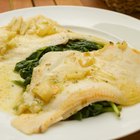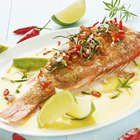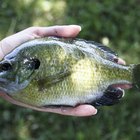lisaaMC/iStock/GettyImages
Haddock is a member of the extended cod clan, a delicate white-fleshed fish that's wild-caught on both sides of the Atlantic. It's usually an economical option for fish-lovers, and the current fishery is quite sustainable: It's a consistent "Good Alternative" in Seafood Watch's seafood recommendations. You'll occasionally see the fish sold whole, but more normally as full fillets or as smaller haddock loin fillets. If you're not sure how to cook haddock, loin fillets are the easiest starting point.
Haddock Loins Explained
A full fillet of haddock follows the same basic template as other conventionally shaped fish. The thickest portion is behind the head and above the backbone, with a thinner area wrapped around the belly cavity and the ribs. The whole fillet then tapers toward the tail end of the fish.
Cooking a whole fillet means the thinner tail end and belly meat are done well before the thicker portion above the backbone, while cutting the fillet into thicker and thinner portions means you have to stagger their cooking times to get everything to the same doneness. Haddock loins solve that problem neatly: They're the thick portion from above the backbone, with the thinner pieces trimmed away. This yields uniform portions that cook evenly, and are thick enough to remain moist and tasty when they're done.
Haddock Loin Recipes
There's no one best way to cook haddock, and a simple internet search for "How to cook haddock" will return hundreds of thousands of hits. As a rule, you'll find that most of the recipes boil down to just a handful of basic techniques. If you choose one recipe you like, and make it a few times to master the technique, you'll soon be able to handle any other recipe using the same technique. The basics are very simple: Don't overcook it until it's dry, and don't season it so heavily you can't taste the delicate fish any more.
Most Useful Techniques
Over time, if you cook haddock loins regularly, you'll learn most or all of these standard techniques:
- Deep Frying: Haddock is a traditional choice for fish and chips, and that's a good starting point. Dry the haddock very well before dipping it in your batter, and fry it in small batches so the cold fish doesn't lower the temperature of the oil too far. Typically, you'll need to cook loins for 5 to 7 minutes in total.
- Pan Frying: Haddock needs some sort of breading to protect its delicate flesh from the searing heat of the pan, and to help prevent it falling apart when you turn it. Use a fairly hot pan, so the breading can brown fully before the quick-cooking fish is done. Allow 3 to 5 minutes per side.
- Oven Baking: Baking is one of the most versatile ways to prepare haddock loins, because you can use any herbs, spices or other toppings you choose and not have to worry about them burning or falling off. A good rule is to allow 10 minutes of baking time per inch of thickness, or typically 8 to 12 minutes for loins.
-
Baking in Sauce:
If you're not sure how to cook haddock, loin fillets are the easiest starting point. Many recipes cook the haddock in a dish with sauce, typically a white sauce or tomato-based sauce. If you start with a warm or hot sauce, this might take only 5 to 8 minutes longer than baking the loins alone. If your sauce is cold or at room temperature it can take longer, so follow your recipe's suggested timing.
En Papillote: This technique is much the same as baking, except you wrap the haddock loins in a pouch of parchment paper before baking them. The parchment traps moisture inside, steaming the haddock loin gently in its own juices and allowing you to infuse it with flavors from herbs, wine or other ingredients. The rule of cooking 10 minutes per inch of thickness applies here, as well.
Grilling: Haddock is too delicate to grill the way you'd do with a salmon fillet or tuna steak, but that doesn't mean you can't. Use one of the mesh baskets designed for fish-grilling, and follow the 10-minute rule. If you don't have a basket, buy or improvise a shallow foil container and oil or spray the inside, then lay the loins on it and cook them for 10 to 15 minutes.
Related Articles
How Long to Bake Swordfish Steaks

How to Cook Kingklip
How to Cook a Turbot in the Oven

Cooking Frozen Swai Fillets
How to Cook Seasoned Keta Salmon

How Long & What Temperature Is It to ...

How to Cook a Pork Loin Fillet

How to Cook a Flounder Filet

How to Bake a Frozen Halibut Fillet
How to Cook Bone-in Tilapia
How to Cook a Bass Fillet
Cooking Haddock

How to Bake Lingcod
How to Cook Atlantic Salmon Fillets

How to Bake Yelloweye Rockfish
How to Cook Grouper in the Oven

How to Cook Bluegill on the Grill

How to Cook a Fresh Perch

How to Bake Salmon - 3 Easy Recipes

How to Cook Ono Fish
References
Tips
- For a heartier change, dip the fillets in a coating of egg, milk and seasoned or plain breadcrumbs or panko. Whisk eggs and milk together in a shallow bowl and have another bowl or plate of the breadcrumbs ready. Dip the fillets in the egg and milk first and then in the crumbs. Shake off the excess and lay gently in the pan in the hot oil. Cook until golden brown, or about two to three minutes, and then turn and repeat on the other side.
- If all you have is a small skillet, cook the fish in multiple batches, keeping the first batch warm on a platter in an oven set at 250 degrees Fahrenheit.
- Accompaniments for pan-fried haddock fillets include freshly-squeeze lemon juice, tartar sauce or cocktail sauce. Because fish cools quickly once it's removed from the pan, have any condiments at room temperature before serving.
- You can cut calories by baking the loin fillets in a pan coated with pan spray. Allow enough space between the fillets and bake at 425 degrees Fahrenheit for about 10 minutes or until the fish is opaque and flakes easily.
Writer Bio
Fred Decker is a trained chef and prolific freelance writer. In previous careers, he sold insurance and mutual funds, and was a longtime retailer. He was educated at Memorial University of Newfoundland and the Northern Alberta Institute of Technology. His articles have appeared on numerous home and garden sites including GoneOutdoors, TheNest and eHow.